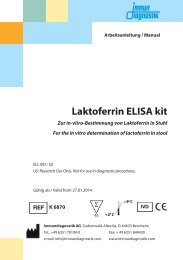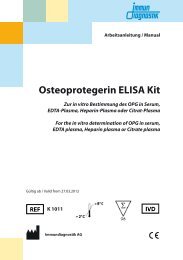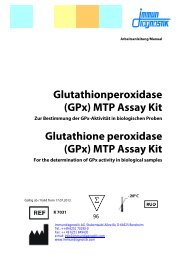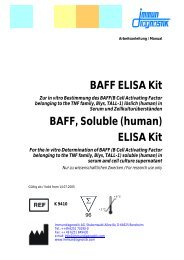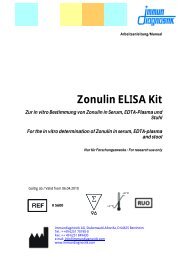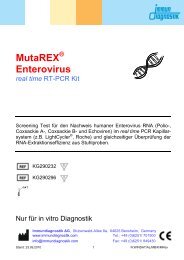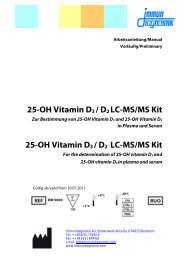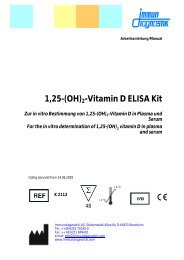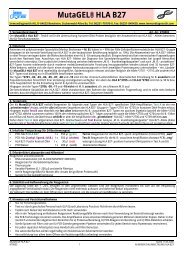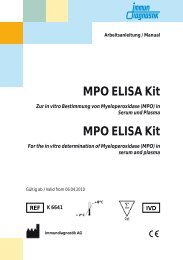Hemoglobin ELISA Kit - bei Immundiagnostik
Hemoglobin ELISA Kit - bei Immundiagnostik
Hemoglobin ELISA Kit - bei Immundiagnostik
You also want an ePaper? Increase the reach of your titles
YUMPU automatically turns print PDFs into web optimized ePapers that Google loves.
Ar<strong>bei</strong>tsanleitung / Manual human <strong>Hemoglobin</strong><br />
1. INTENDED USE<br />
The <strong>Immundiagnostik</strong> Assay is intended for the quantitative determination of human <strong>Hemoglobin</strong><br />
in stool. For In-vitro_diagnostic use only.<br />
2. INTRODUCTION<br />
In contrast to other commercially available <strong>Hemoglobin</strong> quick tests, this <strong>Hemoglobin</strong> <strong>ELISA</strong><br />
does not require previous adherence to a diet (no raw meat etc.) and recognizes human <strong>Hemoglobin</strong><br />
in 100-fold lower concentrations. This avoids false-negative results. Because of the<br />
choice of antibodies, false-positive results are almost excluded.<br />
Recent data show, that the clinical specificity and sensitivity can be increased by using <strong>Hemoglobin</strong><br />
<strong>ELISA</strong>.<br />
Indications<br />
· Occult blood in stool<br />
· Crohn´s disease; Ulcerative Colitis<br />
· Suspicion of colon carcinoma<br />
· Polyps in the colorectum<br />
3. PRINCIPLE OF THE TEST<br />
The Enzyme-Linked-Immuno-Sorbent-Assay (<strong>ELISA</strong>) is used for quantitative determination<br />
of <strong>Hemoglobin</strong> in stool. The <strong>Hemoglobin</strong> in the sample is bound to anti-<strong>Hemoglobin</strong> antibodies<br />
(in excess), which are immobilized on the surface of the microtiter wells. To remove<br />
all unbound substances, a washing step is carried out. In a second incubation step an anti-<br />
<strong>Hemoglobin</strong> peroxidase labeled antibody is added. After another washing step, to remove all<br />
unbound substances, the solid phase is incubated with the substrate, tetramethylbenzidine<br />
(TMB). An acidic solution is then added to stop the reaction. The color converts from blue to<br />
yellow. The intensity of the yellow color is directly proportional to the concentration of <strong>Hemoglobin</strong><br />
in the sample. <strong>Hemoglobin</strong>, present in the patient samples, is quantified by referring<br />
the optical density of patient‘s samples to a Lot-dependant master calibration curve. This is<br />
done by using Reference/Calibrator that is run with each test.<br />
15



